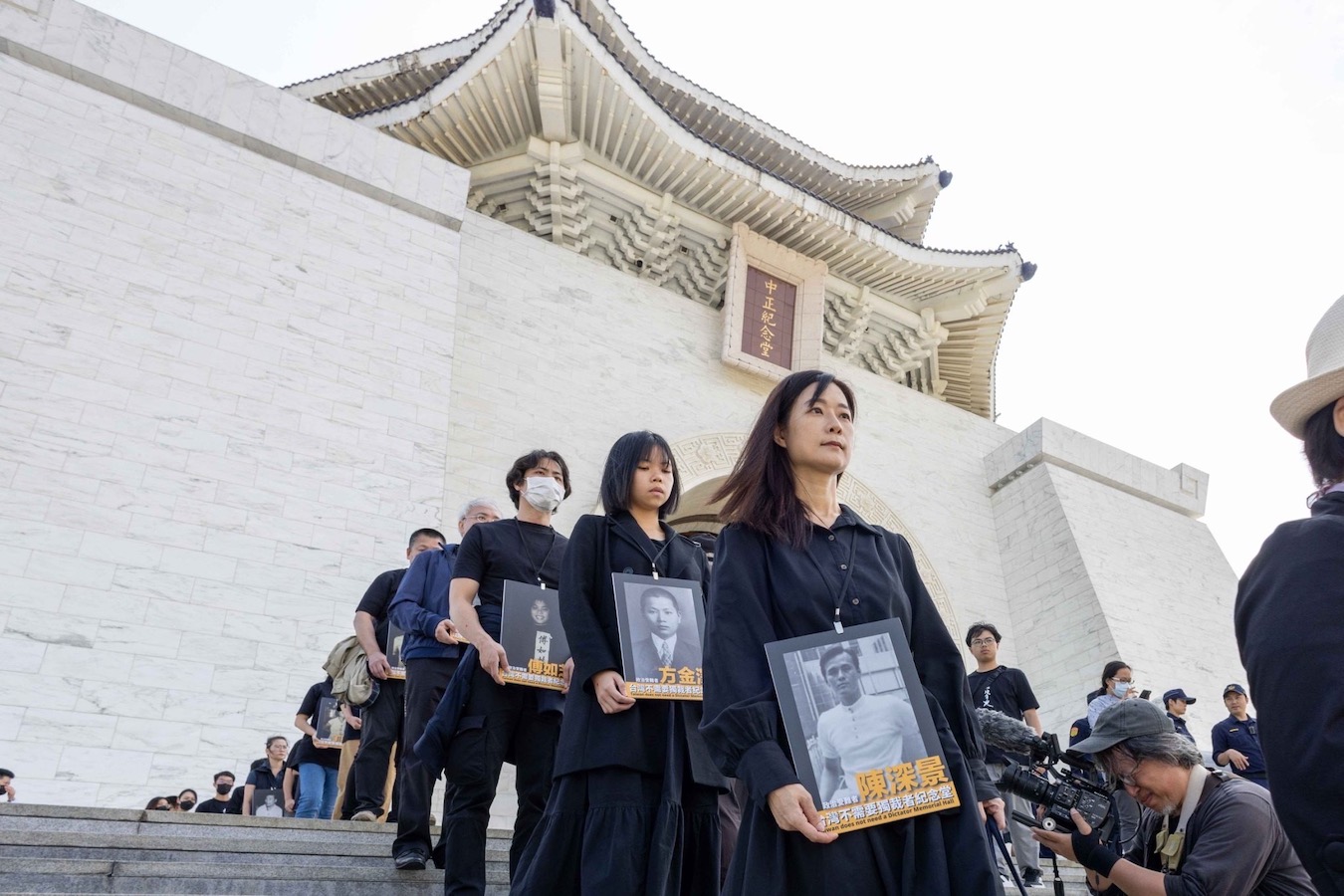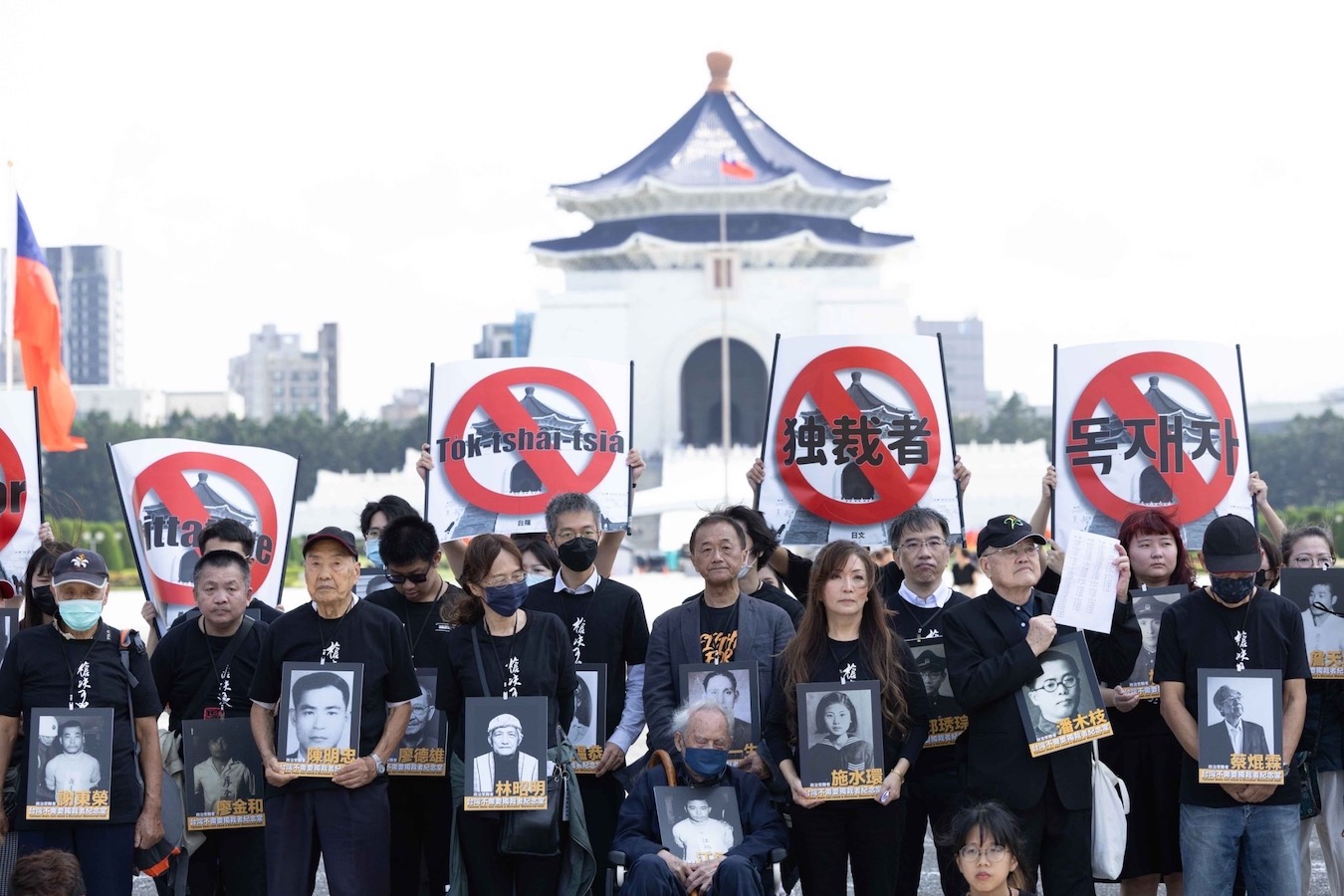by Brian Hioe
語言:
English
Photo Credit: 台灣共生青年協會/Facebook
AROUND 100 INDIVIDUALS demonstrated in front of the Chiang Kai-shek Memorial on October 30th, calling for the demolition of the memorial as part of efforts to realize transitional justice in Taiwan.
Civil society organizations represented at the demonstration included the Dr. Chen Wen-cheng Memorial Foundation, Gongsheng Youth Association, and New Taiwan Peace Foundation. The groups were calling for the Tsai administration to take action on the Chiang Kai-shek Memorial before it ends its second and final term in office.
The demonstration was scheduled for October 30th, seeing as it is Chiang Kai-shek’s birthday on October 31st. The protest was framed as a cross-generational demonstration, with participants including family members of White Terror and 228 Massacre survivors such as relatives of Tsai Kun-lin, who passed away in September at age 92. Indeed, the Dr. Chen Wen-cheng Memorial Foundation commemorates the life and work of Chen Wen-cheng, a Taiwanese Carnegie Mellon whose dead body was found on the campus of National Taiwan University in 1981.
 Photo credit: 台灣共生青年協會/Facebook
Photo credit: 台灣共生青年協會/Facebook
It is suspected that Chen was killed by state security forces from the Taiwan Garrison Command, but the truth about Chen’s death has yet to be clarified, seeing as archives and records of the political killings that took place during the White Terror have not yet been declassified and unveiled. The truth of other significant political killings, such as the killing of dissident Lin Yi-hsiung’s family in 1979, is also officially known.
Records from the 228 Massacre, which took place in 1947, were declassified in 2017 and Tsai vowed to declassify further White Terror documents in 2019. But records from the White Terror could be politically sensitive and involve individuals who are still active in public life today, while most survivors–and culprits–of the 228 Massacre are deceased. More recently, there has been a proposal from the Taiwanese government to periodically review documents after 30 years to see if they still need to be classified.
Yet the demonstration also included members of the younger generation who commemorate the 228 Massacre and White Terror despite having been born after the lifting of martial law. In particular, the Gongsheng Music Festival–Taiwan’s largest 228 Massacre commemoration–is organized by the Gongsheng Youth Association, as an indie rock festival organized by young people that takes place annually on Ketagalan Boulevard.
Participants in the demonstration wore black and carried photos of victims of the 228 Massacre and White Terror. Apart from calling for truth, protesters also called for the Chiang Kai-Shek Memorial to be transformed into a pure public space, rather than a monument to a dictator. Demonstrators held up a sign in English that read “Taiwan does not need a Dictator Memorial Hall,” alongside signs in Mandarin, Taiwanese, Korean, and other languages.
Before its dissolution in May 2022, the Transitional Justice Commission recommended the removal of the 6.3-meter Chiang Kai-Shek statue in the Chiang Kai-Shek Memorial and its conversion into a park remembering the authoritarian period. Likewise, the Transitional Justice Commission in its final recommendations drew attention to the fact that the structure of the Chiang Kai-Shek Memorial was clearly that of a temple to Chiang.
 Photo credit: 台灣共生青年協會/Facebook
Photo credit: 台灣共生青年協會/Facebook
Yet the Tsai administration may be reluctant to pursue further steps for fear of angering pan-Blue traditionalists, who could be motivated to vote against the Tsai administration in upcoming elections if they feel that the Tsai administration is waging war on what they view as national symbols. The KMT continues to venerate its past period when it held exclusive power in Taiwan and it has leveraged on such anxieties about the Tsai administration waging a campaign of “de-Sinicization” to rally its base in past elections. By contrast, one of the incipient motivations for political mobilization around icons of the past authoritarian period is concerns about the future that Taiwan faces if it is annexed by China if the KMT comes back to power.
It is to be seen if such demonstrations manage to center the unresolved issues of transitional justice in public discourse ahead of the 2024 elections. Certainly, one does not expect the Tsai administration to try and rock the boat on the issue, unless it feels like there is a sizable portion of its base that it has to answer to on issues regarding transitional justice.

